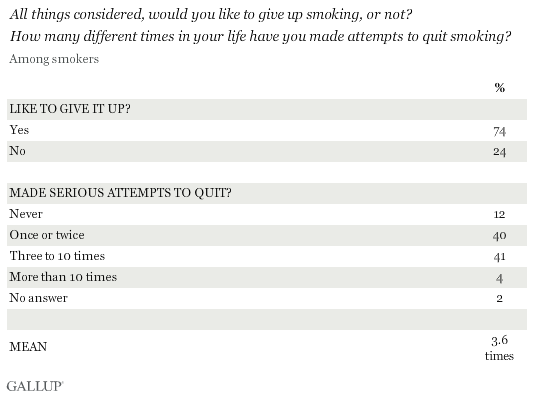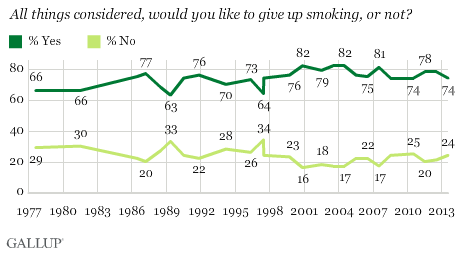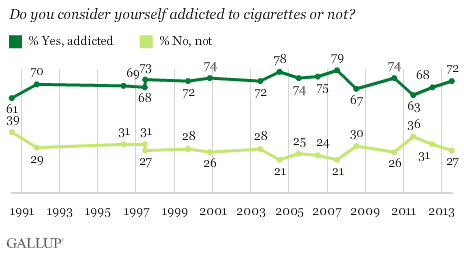PRINCETON, NJ -- Most current smokers in the U.S. would like to give up smoking. Perhaps as a testimony to their desire to quit, 85% of smokers say they have in fact tried to quit at least once in their lifetime, including 45% who have tried at least three times.

These data are from Gallup's annual Consumption Habits poll, conducted July 10-14.
There hasn't been a lot of sustained or significant change in smokers' desires over the years. An average of 74% of smokers have said they wanted to quit over the 25 surveys on which Gallup has asked this question since 1977. There is a small number of smokers in any one sample for which this question is asked, increasing the chances for minor variations from year to year.

The finding that smokers have tried on average 3.6 times to quit smoking over their lifetimes -- only to return to their habit -- is more understandable in light of the fact that 72% of smokers claim that they are "addicted" to cigarettes.
As was the case for the trend in smokers' self-reported desire to quit, this addiction trend has not varied significantly on a sustained basis over the last 22 years. But in 1990, when the question was first asked, 61% of smokers said they were addicted. Of course, it may be in smokers' best interest to claim that they are addicted to smoking, because that mental conviction may help reduce the cognitive dissonance that knowingly engaging in an unhealthy habit can produce.

Overall, 19% of Americans in Gallup's July Consumption Survey say they currently smoke, 24% are former smokers (they used to smoke on a regular basis), and 56% have never smoked. The quarter of Americans who are former smokers are primarily defined by age: 41% of those 65 and older used to smoke, but do not now, compared with 12% of those aged 18 to 29.
Quitters Most Likely to Use "Cold Turkey" Strategy
The quarter of Americans who have successfully quit smoking, when asked to name the strategies or methods they used to quit, are most likely to attribute their success to just deciding to quit "cold turkey." Smaller percentages of reformed smokers name willpower, support from family and friends and prayer, use of the nicotine patch, ceasing to be around people who smoke, using chewing gum or candy, and using an electronic cigarette.
![Trying to be as specific as possible, what strategies or methods for quitting smoking were the most effective for you? [OPEN-ENDED] July 2013 results](http://content.gallup.com/origin/gallupinc/GallupSpaces/Production/Cms/POLL/3ehwjtfcw027bml1rpu_og.png)
Health Cited Most Often as Reason for Quitting
The former smoker group was also asked to detail the major reasons or factors that finally caused them to quit smoking. These reformed smokers were by far most likely to mention factors relating to health, including mentions of pregnancy, bronchitis, cancer, and other causes.
Fewer former smokers say they quit because of the expense of smoking, because smoking was a bad or disgusting habit, or because of their family and friends.
![What were some of the major reasons or factors that caused you to quit smoking? [OPEN-ENDED] July 2013 results](http://content.gallup.com/origin/gallupinc/GallupSpaces/Production/Cms/POLL/uee9fxx1euol0nmik1ug4g.png)
Implications
Smokers on average are engaging in a habit they wish they didn't have, and, in fact, the average smoker has attempted to quit at least three times in their lifetime. The difficulty in quitting is attested to by the fact that more than seven in 10 smokers say they are addicted to cigarettes.
The varied strategies for quitting cited by former smokers suggest there is not a dominant "magic bullet" method, but rather just a basic decision at some point in smokers' lives to quit cold turkey.
The majority of former smokers say their concern for their health was the main factor that caused them to quit smoking. This is an important finding, but given that 91% of smokers already admit that smoking is harmful to smokers' health and 79% admit that smoking is a cause of lung cancer, it is clear that the specter of bad health, disease, and death has not been enough in and of itself to get smokers to stop.
Survey Methods
Results for this Gallup poll are based on telephone interviews conducted July 10-14, 2013, on the Gallup Daily tracking survey, with a random sample of 2,027 adults, aged 18 and older, living in all 50 U.S. states and the District of Columbia.
For results based on the samples of 972 national adults in Form A and 1,055 national adults in Form B, the margin of sampling error is ±4 percentage points.
For results based on the sample of 338 smokers, the maximum margin of sampling error is ±6 percentage points.
For results based on the sample of 546 former smokers, the maximum margin of sampling error is ±5 percentage points.
Interviews are conducted with respondents on landline telephones and cellular phones, with interviews conducted in Spanish for respondents who are primarily Spanish-speaking. Each sample of national adults includes a minimum quota of 50% cellphone respondents and 50% landline respondents, with additional minimum quotas by region. Landline and cell telephone numbers are selected using random-digit-dial methods. Landline respondents are chosen at random within each household on the basis of which member had the most recent birthday.
Samples are weighted to correct for unequal selection probability, nonresponse, and double coverage of landline and cell users in the two sampling frames. They are also weighted to match the national demographics of gender, age, race, Hispanic ethnicity, education, region, population density, and phone status (cellphone only/landline only/both, and cellphone mostly). Demographic weighting targets are based on the March 2012 Current Population Survey figures for the aged 18 and older U.S. population. Phone status targets are based on the July-December 2011 National Health Interview Survey. Population density targets are based on the 2010 census. All reported margins of sampling error include the computed design effects for weighting.
In addition to sampling error, question wording and practical difficulties in conducting surveys can introduce error or bias into the findings of public opinion polls.
View methodology, full question results, and trend data.
For more details on Gallup's polling methodology, visit www.gallup.com.
